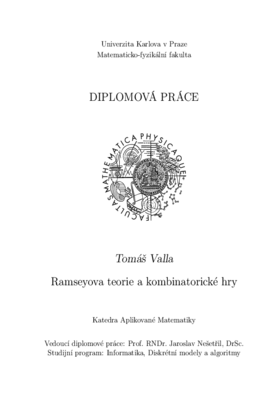Ramseyova teorie a kombinatorické hry
Ramseyova teorie a kombinatorické hry
diplomová práce (OBHÁJENO)

Zobrazit/
Trvalý odkaz
http://hdl.handle.net/20.500.11956/4442Identifikátory
SIS: 41395
Katalog UK: 990014678250106986
Kolekce
- Kvalifikační práce [11424]
Autor
Vedoucí práce
Oponent práce
Valtr, Pavel
Fakulta / součást
Matematicko-fyzikální fakulta
Obor
Diskrétní matematika a optimalizace
Katedra / ústav / klinika
Katedra aplikované matematiky
Datum obhajoby
22. 5. 2006
Nakladatel
Univerzita Karlova, Matematicko-fyzikální fakultaJazyk
Angličtina
Známka
Výborně
Ramseyova teorie studuje vnitřní homogenitu matematických struktur (grafů, číselných oborů), jejichž části (podgrafy, podmnožiny) jsou libovolně obarveny. Často platí, že je-li studovaný objekt dostatečně velký, lze v něm najít určitý jednobarevný podobjekt. Kombinatorické hry jsou hry dvou hráčů s plnou informací, kde záleží pouze na jejich inteligenci. Teorie kombinatorických her studuje především otázky existence vyhrávajících či neprohrávajících strategií. Vezmeme-li ramseyovskou větu a necháme-li objekt, který tato věta studuje, střídavě barvit dvěma hráči, jejichž cílem je vytvořit určitý monochromatický podobjekt, dostaneme kombinatorickou hru. Předmětem našeho zájmu je jednak nejmenší velikost objektu, při které platí ramseyovská věta, tzv. ramseyovské číslo, a jednak nejmeněí velikost téhož objektu, při které má první hráč vyhrávající strategii v příslušné kombinatorické hře, tzv. herní číslo. V této práci popisujeme takové ramseyovské věty, u nichž je ramseyovské číslo podstatně větší než číslo herní. To znamená, že podáváme důkazy existence vyhrávajících strategií prvního hráče spolu s horními odhady na ramseyovská a herní čísla a obě čísla porovnáváme.
Ramsey theory studies the internal homogenity of mathematical structures (graphs, number sets), parts of which (subgraphs, number subsets) are arbitrarily coloured. Often, the sufficient object size implies the existence of a monochromatic sub-object. Combinatorial games are 2-player games of skill with perfect information. The theory of combinatorial games studies mostly the questions of existence of winning or drawing strategies. Let us consider an object that is studied by a particular Ramsey-type theorem. Assume two players alternately colour parts of this object by two colours and their goal is to create certain monochromatic sub-object. Then this is a combinatorial game. We focus on the minimum object size such that the appropriate Ramsey-type theorem holds, called Ramsey number, and on the minimum object size such that the rst player has a winning strategy in the corresponding combinatorial game, called game number. In this thesis, we describe such Ramsey-type theorems where the Ramsey number is substantially greater than the game number. This means, we show the existence of rst player's winning strategies, zogether with Ramsey and game numbers upper bounds, and we compare both numbers.
